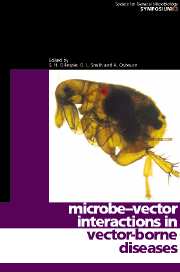Book contents
- Frontmatter
- Contents
- Contributors
- Editors' Preface
- 1 Vector-borne diseases
- 2 Evolution of tick-borne disease systems
- 3 Insect transmission of viruses
- 4 RNA-based immunity in insects
- 5 Specificity of Borrelia–tick vector relationships
- 6 Bunyavirus/mosquito interactions
- 7 How do mosquito vectors live with their viruses?
- 9 Vector competence
- 9 Environmental influences on arbovirus infections and vectors
- 10 Vector immunity
- 11 Transmission of plant viruses by nematodes
- 12 Wolbachia host–symbiont interactions
- 13 Pathogenic strategies of Anaplasma phagocytophilum, a unique bacterium that colonizes neutrophils
- 14 Interactions of Yersinia pestis with its flea vector that lead to the transmission of plague
- 15 Transgenic malaria
- 16 Vaccines targeting vectors
- Index
12 - Wolbachia host–symbiont interactions
Published online by Cambridge University Press: 06 July 2010
- Frontmatter
- Contents
- Contributors
- Editors' Preface
- 1 Vector-borne diseases
- 2 Evolution of tick-borne disease systems
- 3 Insect transmission of viruses
- 4 RNA-based immunity in insects
- 5 Specificity of Borrelia–tick vector relationships
- 6 Bunyavirus/mosquito interactions
- 7 How do mosquito vectors live with their viruses?
- 9 Vector competence
- 9 Environmental influences on arbovirus infections and vectors
- 10 Vector immunity
- 11 Transmission of plant viruses by nematodes
- 12 Wolbachia host–symbiont interactions
- 13 Pathogenic strategies of Anaplasma phagocytophilum, a unique bacterium that colonizes neutrophils
- 14 Interactions of Yersinia pestis with its flea vector that lead to the transmission of plague
- 15 Transgenic malaria
- 16 Vaccines targeting vectors
- Index
Summary
INTRODUCTION
Wolbachia are obligate intracellular bacteria that infect a wide range of invertebrate hosts (O'Neill et al., 1997). As a genus they are most closely related to the arthropodtransmitted bacteria Ehrlichia within the Rickettsiaceae (Fig. 1a). Wolbachia are widespread throughout insects and also infect crustaceans, mites and filarial nematodes. The extent of their distribution is still not well understood but they are already among the most abundant and widespread bacterial symbionts so far described. Wolbachia have evolved a diversity of associations with their hosts, ranging from being pathogens and reproductive parasites in arthropods to mutualists in filarial nematodes. A common target of Wolbachia is the host's reproductive system, which is manipulated to enhance the spread of the symbiont throughout populations. In arthropods, the bacteria have developed a bewildering repertoire of strategies with which to manipulate host reproduction. They can affect the fertility of hosts by controlling compatibility between infected males and uninfected females (cytoplasmic incompatibility), alter sex ratios by killing males or by inducing asexual production of female offspring (parthenogenesis) and even turn males into females (feminization). Not all associations, however, are weighted in favour of the bacteria. In a species of parasitic wasp which feeds on Drosophila, egg production is dependent on Wolbachia (Dedeine et al., 2001), and in filarial nematodes the symbionts are strict mutualists, essential for larval and embryo development and the survival of adult worms (Taylor, 2002). The diversity of association and phenotype in Wolbachia provides an excellent opportunity to study the nature, mechanisms and evolution of these different host–symbiont interactions.
- Type
- Chapter
- Information
- Microbe-vector Interactions in Vector-borne Diseases , pp. 287 - 300Publisher: Cambridge University PressPrint publication year: 2004
- 1
- Cited by



